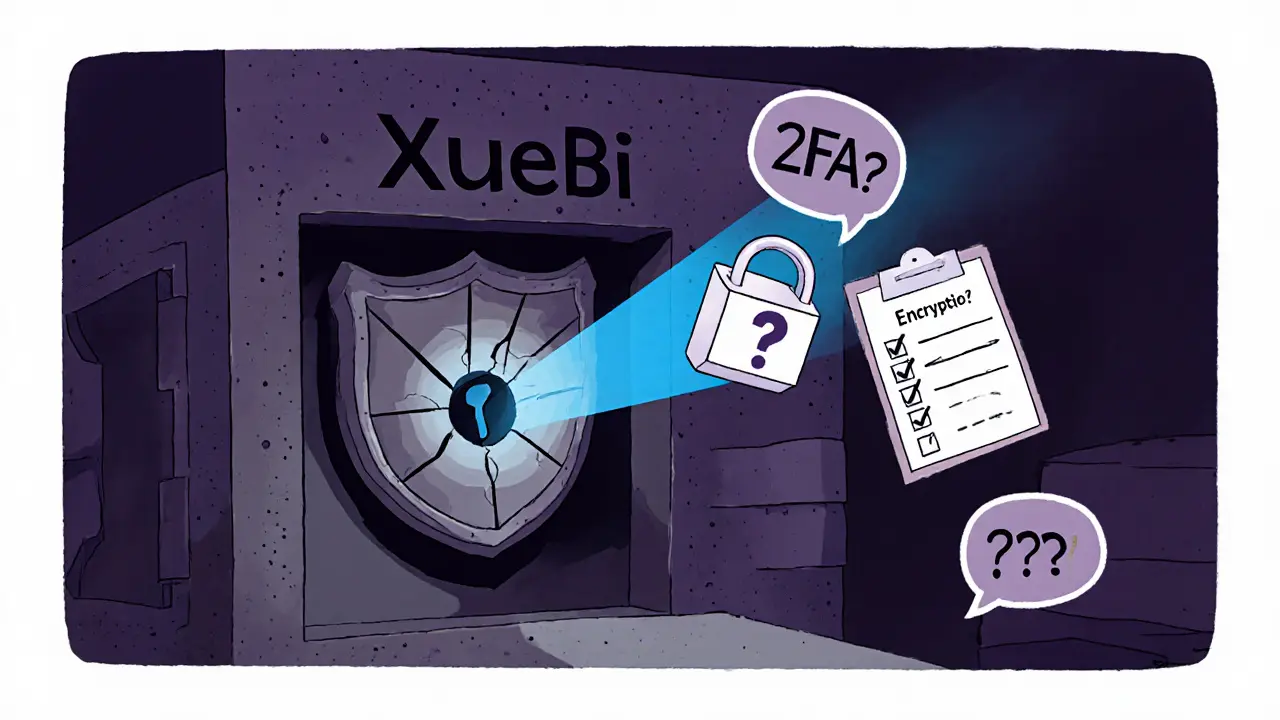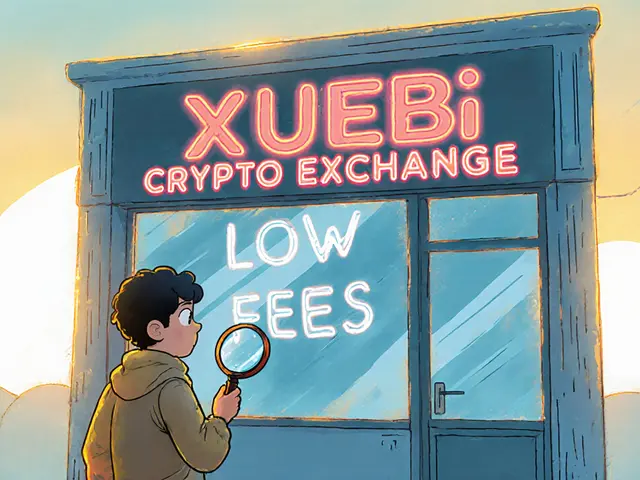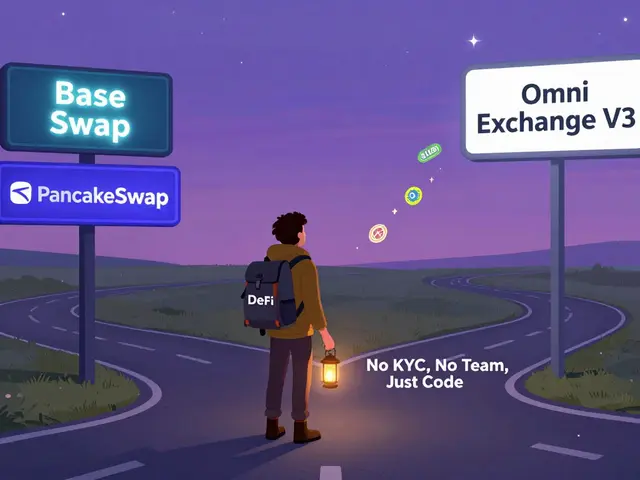Crypto Exchange Risk Assessment Tool
How secure is XueBi for your trading needs?
Answer a few questions to get a personalized risk assessment based on XueBi's transparency and security features.
Risk Assessment Result
If you’re hunting for a crypto exchange that promises low fees but offers very little transparency, you’ve probably run into XueBi Crypto Exchange. This Xuebi exchange review breaks down everything you need to know before you decide whether to put any of your digital assets on the platform.
What XueBi actually offers
At a glance, XueBi lets you buy, sell, and trade more than 50 cryptocurrencies. The list includes the big names - Bitcoin (BTC) and Ethereum (ETH) - plus a handful of mid‑cap tokens. The exchange does not publish a full catalog, so you’ll need to check the UI for any missing coins.
Deposit and withdrawal options are described as “multiple payment methods,” but the exact fiat currencies supported and the processors used are never named. In practice, users report being able to move funds via bank transfer and a few e‑wallets, but you’ll have to test each method yourself.
Security and regulatory red flags
Security is the first line of defense for any exchange, and XueBi’s public statements are vague. The platform mentions standard measures such as two‑factor authentication (2FA) and encryption, but it does not disclose how much of the user balance is kept in cold storage or whether it carries any insurance.
Unlike regulated giants like Coinbase or Kraken, XueBi has no listed licences from any financial authority. The lack of a clear regulator means the exchange does not fall under the Financial Action Task Force ‘Travel Rule’ compliance framework, nor does it appear to be audited against the Crypto Security Standard (CCSS) or ISO/IEC 27001. In a market where hacks have cost investors over $600million (see the 2018 Curtin University report), that opacity is a serious warning sign.
For those who still want to use XueBi, treat it like any other unregulated platform: enable 2FA with an authenticator app (avoid SMS), keep only a small amount on the exchange, and store the bulk of your holdings in a hardware wallet.
Fees - what you’ll actually pay
XueBi advertises a “variable fee” model that changes with trading volume, a common approach among exchanges. Unfortunately, the exact maker‑taker percentages and withdrawal charges are not posted publicly, so you can’t compare them directly to the flat‑rate 0.5% fee on Binance or the tiered 0%‑0.5% maker fee on Coinbase. Users have complained about occasional “higher than expected” withdrawal costs, especially for smaller fiat withdrawals.
If fee transparency is a priority for you, you’ll likely find XueBi lagging behind the industry leaders that publish full fee schedules on their websites.

User experience - how easy is it to trade?
The web interface is clean enough for basic buying and selling, and a mobile app exists for iOS12+ and Android8.0+. However, the platform does not list advanced order types (stop‑loss, OCO, etc.) or provide built‑in charting tools beyond simple price lines. There is no public API documentation, which means algorithmic traders or developers looking to integrate XueBi into bots will hit a dead end.
Customer support is limited to email and live chat. The review you’re reading notes that response‑time metrics are not disclosed, and there are no community forums, Reddit threads, or Trustpilot scores to gauge overall satisfaction. By contrast, Gemini offers 24/7 live chat with average replies under two minutes, and Kraken runs an active Reddit community with over 350k members.
How XueBi stacks up against the big players
| Feature | XueBi | Coinbase | Binance | Kraken |
|---|---|---|---|---|
| Supported assets | ~50 | 200+ | 350+ | 200+ |
| Regulatory licence | None disclosed | NYDFS BitLicense | Multiple (Dubai VARA, others) | US state money‑transmitter licences |
| Cold storage % | Not disclosed | ~98% (insured) | ~70% (partial insurance) | ~95% (insured) |
| 2FA method | Auth app or SMS | Auth app only | Auth app, SMS, YubiKey | Auth app, YubiKey |
| Fee clarity | Variable, not published | Transparent tiered schedule | Clear maker‑taker rates | Transparent tiered schedule |
| API access | None publicly listed | Full REST & WebSocket API | Full REST & WebSocket API | Full REST & WebSocket API |
From the table it’s clear that XueBi lags behind on regulation, security transparency, and developer tools. If you need any of those features, the more established exchanges are safer bets.
Who might still consider XueBi?
Despite the shortcomings, XueBi could appeal to a narrow slice of traders:
- Users living in regions where the bigger exchanges are blocked or face heavy KYC friction.
- People looking for a simple buy‑and‑hold interface without the clutter of advanced trading tools.
- Traders willing to keep only a small working balance on the exchange while storing the majority offline.
If any of those points match your situation, test the platform with a tiny amount first. Make sure withdrawals work smoothly before you grow your position.

Safety checklist if you decide to go ahead
- Enable a hardware authenticator (Google Authenticator, Authy) and disable SMS codes.
- Set up withdrawal address whitelisting if the feature exists.
- Transfer only the amount you plan to trade that day; keep the rest in a hardware wallet.
- Take screenshots of fee receipts and keep a log of deposit/withdrawal times.
- Regularly review the platform’s terms of service for any sudden policy changes.
Following these steps reduces the risk of losing assets to a hack or an unexpected account freeze.
Bottom line
XueBi Crypto Exchange offers a decent list of coins and a straightforward UI, but the missing pieces-clear regulation, published security practices, transparent fees, and developer tools-make it a risky choice for most traders. If you value security and compliance, stick with a licensed exchange that openly shares its audit reports and fee schedule. If you have no other option and are willing to accept higher risk, treat XueBi as a temporary gateway to move crypto in and out of your cold storage.
Frequently Asked Questions
Is XueBi regulated in any jurisdiction?
No public licence or regulator is listed on XueBi’s website. This means the exchange operates without clear oversight, which raises compliance and legal concerns.
What security features does XueBi provide?
The platform mentions two‑factor authentication, encryption, and cold storage, but it does not disclose the proportion of funds kept offline or any insurance coverage. Users should add their own protections, like hardware wallets.
How many cryptocurrencies can I trade on XueBi?
Around 50 assets are listed, including major coins such as Bitcoin and Ethereum. The exact list isn’t publicly documented, so you’ll need to check the exchange UI for specifics.
Are the fees on XueBi competitive?
Fees are described as “variable” based on volume, but the exact maker‑taker percentages and withdrawal charges are not published. Compared with the clearly listed rates on Binance, Coinbase, or Kraken, XueBi appears less transparent.
Can I use an API to trade on XueBi?
No public API documentation is available. If you need programmatic access, you’ll have to look at other exchanges that provide full REST and WebSocket APIs.







Millsaps Crista
October 16, 2025 AT 08:05If you’re set on trying XueBi, start with a tiny stake and keep the rest in a hardware wallet.
Matthew Homewood
October 21, 2025 AT 21:35Reading through the review, it becomes clear that the lack of regulatory oversight is the main red flag. While the interface looks clean, transparency matters more than aesthetics. A platform that doesn’t publish its fee schedule or cold‑storage ratios leaves users guessing. If you value predictability, you might want to keep looking at exchanges with public audits.
Shane Lunan
October 27, 2025 AT 10:05Looks like another sketchy site.
They hide fees.
No API.
What’s the point?
Jeff Moric
November 1, 2025 AT 23:35From a user‑experience standpoint, XueBi does offer a straightforward buy‑and‑hold flow, which can be handy for newcomers. However, the absence of advanced order types and community support makes it feel isolated. If you’re trading small amounts and need a simple gateway, it might work, but you lose out on tools that bigger platforms provide. Always balance convenience with security.
Bruce Safford
November 7, 2025 AT 13:05Okay, let’s get real here – you’re basically handing your crypto over to a black box that refuses to publish any real data. I’ve seen this pattern before: first they promise “low fees,” then you discover hidden withdrawal charges that siphon off a chunk of your deposits. Don’t forget that they don’t even list what portion of assets sits in cold storage, so you’re walking into a potential hack without a safety net. And the fact they have zero regulatory licence? That’s a massive red flag, especially when you have to rely on vague 2FA and encryption claims. I’d advise anyone with even a modest portfolio to stay far away until they provide a transparent audit report. The risk/reward ratio simply doesn’t add up.
Blue Delight Consultant
November 13, 2025 AT 02:35The philosophical angle here is that an exchange’s credibility is built on openness. When a platform shrouds its fee structure in mystery, it forces users into a state of uncertainty that is antithetical to sound investment practice. Moreover, the lack of disclosed cold‑storage percentages denies users the reassurance that a significant portion of their assets is protected from online threats. In sum, transparency should be a baseline requirement, not an optional luxury.
Wayne Sternberger
November 18, 2025 AT 16:05I appreciate the thoughtful analysis above, and I would add that for users seeking a professional-grade service, the absence of a public API is a serious limitation. A robust exchange should cater not only to casual traders but also to developers aiming to build automated strategies. While the UI may be clean, the missing technical infrastructure can hinder growth. It would be prudent for XueBi to consider publishing comprehensive documentation to attract a broader audience.
Gautam Negi
November 24, 2025 AT 05:35Ah, the drama of an unregulated exchange! In a world where compliance is becoming the norm, XueBi’s refusal to disclose any licences makes it the black sheep of the industry. Still, for those living behind firewalls where the big players are blocked, it could serve as a digital lifeline-if you’re willing to gamble on opacity. The platform’s modest asset list might actually be a blessing, keeping things simple for the uninitiated.
Shauna Maher
November 29, 2025 AT 19:05Let’s cut the nonsense – you’re basically trusting a secret society with your money. They brag about “multiple payment methods,” yet never name a single fiat partner, which screams hidden agendas. If they truly cared about users, they’d lay out the fee schedule in plain sight. This is the kind of setup that regulators love to hunt down, and rightfully so. Stay away unless you’re ready to lose everything to a surprise withdrawal surcharge.
Kyla MacLaren
December 5, 2025 AT 08:35I see both sides here. On one hand, XueBi’s simple UI can be attractive for beginners who just want to dip their toes. On the other, the lack of community resources means you’re on your own when something goes wrong. It might be a decent stop‑gap if you’re locked out of other services, but I’d still recommend moving to a more transparent exchange for the long term.
Linda Campbell
December 10, 2025 AT 22:05From a patriotic perspective, we should be wary of platforms that operate without the oversight of our trusted financial authorities. Allowing an opaque exchange to handle our nation’s digital assets threatens economic sovereignty. It’s not just about personal loss; it’s about collective risk. If you value national security, steer clear of XueBi and support regulated, home‑grown alternatives.
John Beaver
December 16, 2025 AT 11:35When evaluating any crypto exchange, the first thing to examine is the security architecture. XueBi claims to use two‑factor authentication, but it does not disclose whether it supports time‑based one‑time passwords (TOTP) only or also offers hardware‑based keys such as YubiKey. Without clear information, users cannot assess the true resilience against phishing attacks. The second factor to consider is cold‑storage strategy. Industry best practices suggest keeping at least 95% of user funds offline, yet XueBi provides no data on its hot‑wallet exposure, which means a potential breach could affect the majority of assets.
Third, regulatory compliance is not a mere bureaucratic hurdle; it serves as a consumer protection mechanism. Exchanges licensed by bodies like the NYDFS BitLicense or the FCA undergo regular audits, ensuring that they meet capital reserve requirements and adhere to anti‑money‑laundering (AML) standards. In the absence of such oversight, users are left without recourse if the platform collapses or engages in illicit activity. Fourth, fee transparency is essential for cost‑effective trading. Hidden withdrawal fees, especially on low‑volume transactions, can erode profits and surprise traders with unexpected charges. A clear, tiered fee schedule empowers users to calculate net returns accurately.
Fifth, the availability of developer tools such as REST and WebSocket APIs is a differentiator for advanced traders. XueBi’s lack of public API documentation prevents algorithmic trading and integration with portfolio management tools. This limitation confines users to the web UI, which may not support the speed and customization required for high‑frequency strategies. Sixth, customer support quality directly affects user experience during critical moments, such as account recovery or withdrawal delays. A platform that only offers email and limited live chat, without published response‑time metrics, can leave users stranded.
Seventh, consider the legal jurisdiction of the exchange. Operating from an undefined region can expose users to sudden regulatory crackdowns, as seen with several offshore exchanges that were forced to cease operations without warning. Eighth, the exchange’s internal governance, including how it handles security incidents, is often disclosed in post‑mortem reports. Without such transparency, the community cannot gauge the effectiveness of the response plan. Ninth, the platform’s roadmap and commitment to continuous improvement matter; regular updates signal a proactive approach to addressing vulnerabilities and adding features.
Finally, a prudent strategy is to treat any unregulated exchange as a temporary conduit. Deposit only the amount you intend to trade that day, keep the bulk of your holdings in a hardware wallet, and rigorously document every transaction for future reference. By following these best‑practice measures, you can mitigate the inherent risks associated with platforms like XueBi while still leveraging their utility when no alternatives exist.